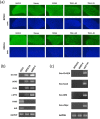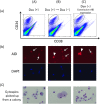Establishment of induced pluripotent stem cells from normal B cells and inducing AID expression in their differentiation into hematopoietic progenitor cells
- PMID: 28490810
- PMCID: PMC5431994
- DOI: 10.1038/s41598-017-01627-1
Establishment of induced pluripotent stem cells from normal B cells and inducing AID expression in their differentiation into hematopoietic progenitor cells
Abstract
B cell derived induced pluripotent stem cells (BiPSCs) were recently established from peripheral blood B cells by the simultaneous transfection of Yamanaka factors (Oct3/4, Sox2, Klf4, c-Myc) and C/EBPα using a Sendai virus vector. Here, using a different method, we established BiPSCs with immunoglobulin heavy chain (IgH) gene rearrangement from normal B cells purified from lymph nodes. The critical points of our method are pre-stimulation of B cells with IL-21 and CD40-ligand (CD40L), followed by consecutive transfection of highly concentrated Yamanaka factors using a retroviral vector. Following each transfection the cells were centrifuged onto a retronectin coated plate and the activated by IL-4, IL-2, and CD40L. Furthermore, we established BiPSCs (BiPSC-A) in which activation-induced cytidine deaminase (AID) could be induced using the doxycycline-controlled. Both the parental BiPSC and BiPSC-A showed the capability of differentiating into hematopoietic progenitor cells (HPCs) based on confirmation of CD34 expression and colony-formation from CD34-positive cells. The findings that BiPSC-A can differentiate into HPCs suggest that there is a possibility that induction of AID expression would result in chromosomal translocations in the process of differentiation from BiPSCs, and therefore that these BiPSCs could be useful in elucidating the tumor origin of abnormal B cells in myelomagenesis.
Conflict of interest statement
The authors declare that they have no competing interests.
Figures







Similar articles
-
Chromosomal translocation t(11;14) and p53 deletion induced by the CRISPR/Cas9 system in normal B cell-derived iPS cells.Sci Rep. 2021 Mar 4;11(1):5216. doi: 10.1038/s41598-021-84628-5. Sci Rep. 2021. PMID: 33664418 Free PMC article.
-
Generation of induced pluripotent stem cells from buffalo (Bubalus bubalis) fetal fibroblasts with buffalo defined factors.Stem Cells Dev. 2012 Sep 1;21(13):2485-94. doi: 10.1089/scd.2012.0018. Epub 2012 May 14. Stem Cells Dev. 2012. PMID: 22420535
-
Generation of Naïve Bovine Induced Pluripotent Stem Cells Using PiggyBac Transposition of Doxycycline-Inducible Transcription Factors.PLoS One. 2015 Aug 19;10(8):e0135403. doi: 10.1371/journal.pone.0135403. eCollection 2015. PLoS One. 2015. PMID: 26287611 Free PMC article.
-
The in vitro and in vivo effects of stem cell factor on human hematopoiesis.Stem Cells. 1993 Jul;11 Suppl 2:76-82. doi: 10.1002/stem.5530110813. Stem Cells. 1993. PMID: 7691331 Review.
-
Progenitor and precursor B lymphocytes of mice. Proliferation and differentiation in vitro and population, differentiation and turnover in SCID mice in vivo of normal and abnormal cells.Curr Top Microbiol Immunol. 1992;182:3-12. doi: 10.1007/978-3-642-77633-5_1. Curr Top Microbiol Immunol. 1992. PMID: 1490368 Review. No abstract available.
Cited by
-
Chromosomal translocation t(11;14) and p53 deletion induced by the CRISPR/Cas9 system in normal B cell-derived iPS cells.Sci Rep. 2021 Mar 4;11(1):5216. doi: 10.1038/s41598-021-84628-5. Sci Rep. 2021. PMID: 33664418 Free PMC article.
-
Induction of t(11;14) IgH enhancer/promoter-cyclin D1 gene translocation using CRISPR/Cas9.Oncol Lett. 2019 Jul;18(1):275-282. doi: 10.3892/ol.2019.10303. Epub 2019 May 2. Oncol Lett. 2019. PMID: 31289497 Free PMC article.
-
The Post-GWAS Era: How to Validate the Contribution of Gene Variants in Lupus.Curr Rheumatol Rep. 2019 Jan 23;21(1):3. doi: 10.1007/s11926-019-0801-5. Curr Rheumatol Rep. 2019. PMID: 30673885 Review.
-
ΔNp63α transcriptionally represses p53 target genes involved in the radiation-induced DNA damage response : ΔNp63α may cause genomic instability in epithelial stem cells.Radiat Oncol. 2022 Nov 15;17(1):183. doi: 10.1186/s13014-022-02139-7. Radiat Oncol. 2022. PMID: 36380314 Free PMC article.
References
Publication types
MeSH terms
Substances
LinkOut - more resources
Full Text Sources
Other Literature Sources
Medical
Research Materials

